Top Conga Composer Alternative: MergeUp vs Conga Composer Comparison : Antonina Kharchenko
by: Antonina Kharchenko
blow post content copied from Salesforce Apps
click here to view original post
### Summary of "Why Teams Need Tools for Salesforce Documents" Sales and service teams frequently handle various documents like quotes, contracts, and invoices. Traditionally, these documents are created using Word or by copying from previous files, which can lead to errors and inefficiencies. For instance, preparing a contract can take an hour without the right tools, delaying the sales process. **Key Insights:** - Document generation is essential for Salesforce teams, with over 60% of mid-to-large users adopting automation tools. - Teams using document generation tools can produce documents up to 70% faster and reduce errors significantly. - MergeUp and Conga Composer are two standout document generation apps on Salesforce's AppExchange. **MergeUp Features:** - AI Template Builder for easy document creation. - User-friendly interface for admins. - Supports conditional logic and batch document generation. - Fast setup, allowing teams to create documents quickly. **Conga Composer Features:** - Established tool with extensive capabilities for document automation. - Supports multiple formats and complex templates. - Requires more technical knowledge for setup and management. **Comparison Highlights:** - **Ease of Use:** MergeUp is simpler and faster to set up, while Conga Composer requires more technical expertise. - **Automation:** MergeUp offers straightforward batch generation, whereas Conga Composer has advanced automation features but may need additional configuration. - **Pricing:** MergeUp uses a per-org subscription model, making costs predictable, while Conga Composer's per-user pricing can complicate budgeting. **Conclusion:** MergeUp is recommended for teams seeking speed and simplicity in document generation, while Conga Composer is suitable for organizations needing complex document handling and integration. ### Additional Context Document automation tools are becoming increasingly vital for businesses to enhance efficiency, reduce errors, and maintain professionalism in their documentation processes. As teams grow and document needs become more complex, choosing the right tool can significantly impact productivity. ### Hashtags for SEO #Salesforce #DocumentAutomation #MergeUp #CongaComposer #SalesTools #Efficiency #BusinessAutomation #DocumentGeneration #SalesforceApps #ProductivityTools
Why Teams Need Tools for Salesforce Documents
Sales and service teams deal with documents every single day. They create quotes for new deals, renewal contracts, service agreements, and invoices. Often, these are built in Word or copied from old files. Numbers are typed manually, details are missed, and updates take extra time. It slows down their work.
For example, imagine a sales rep who closes a deal. They need to pull product details, customer data, and pricing from Salesforce into a contract. Without the right tool, it can take an hour just to prepare the document instead of moving on to the next customer.
Insight:
Document generation is no longer optional for Salesforce teams.
According to Global Growth Insights, over 60% of mid-to-large Salesforce users are using these tools, up from 45% three years ago.
Teams that adopt them see major benefits: they can deliver proposals, contracts, and invoices up to 70% faster, reduce mistakes by more than half, and keep branding consistent across regions.
This shows how critical document automation has become for speed, accuracy, and professionalism.
That’s why the teams look for a document generator Salesforce app to make this process faster. MergeUp combines speed with advanced flexibility, it’s designed for teams that want quick results without sacrificing power. Conga Composer remains a capable tool for complex or legacy setups, but often requires more configuration and technical effort. Templates in both apps can pull in the right data automatically, follow business rules, and let documents be ready in minutes.
We looked at the available apps on AppExchange, and two stood out: MergeUp, the first document generation app that uses AI for template creation, and Conga Composer, a well-established solution with a long track record and broad adoption.
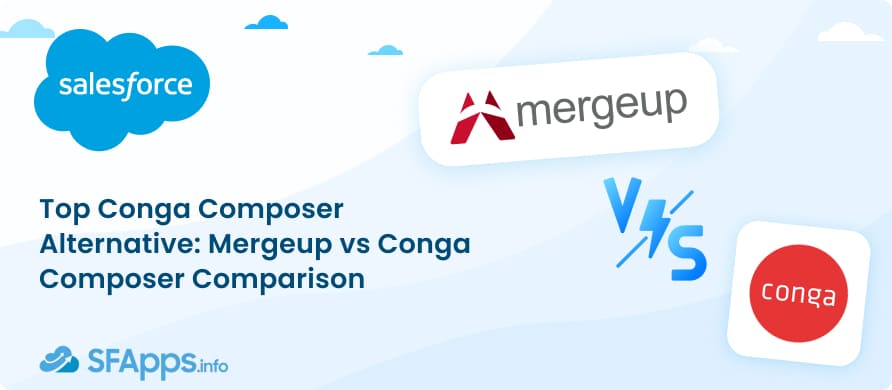
So, in this article, we will look at how to set up both tools, build and manage templates, apply logic, and compare their features, security, and pricing. To make the comparison clear, we’ll walk through each area step by step, add star ratings, and highlight the overall winner at the end.
- What is the MergeUp App
- What is the Conga Composer App
- Feature-by-Feature Comparison: MergeUp vs. Conga Composer
- Security and Governance: MergeUp vs. Conga Composer
- Scalability Comparison: MergeUp vs. Conga Composer
- Pricing Overview
- What Users Say: MergeUp vs. Conga Composer
- Making the Right Choice for Your Team
What is the MergeUp App
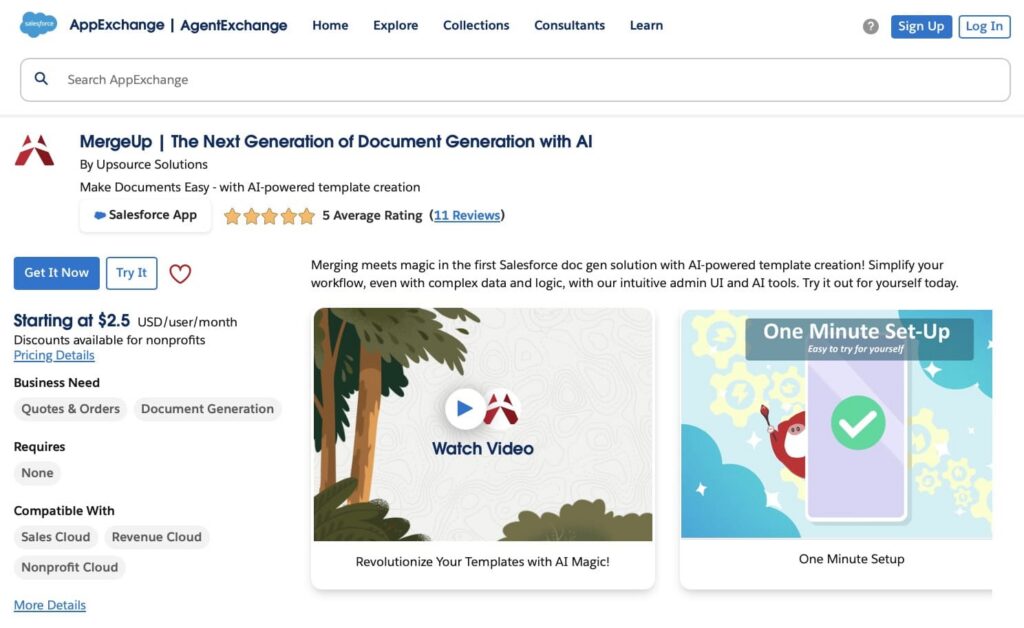
MergeUp on AppExchange
MergeUp is a next-generation document generation solution built for Salesforce teams that need speed, flexibility, and simplicity. Designed with admins and developers in mind, MergeUp streamlines template creation and document automation so businesses can scale without compromise.
Key features include:
- AI Template Builder: Upload a Word doc and let AI map Salesforce fields automatically.
- Admin-Friendly UI: Adjust mappings, add rules, and preview results with no code.
- Conditional Logic & Looping: Show or hide sections, pull in child records, and build flexible tables.
- JavaScript Support: Handle advanced calculations and formatting inside templates.
- Batch Generation: Generate multiple documents efficiently, with individual templates processed quickly.
- APIs & Flow Integration: Automate document creation at scale.
Why teams choose MergeUp:
MergeUp combines fast setup, powerful customization, and enterprise scalability, making it one of the strongest Salesforce-native Conga Composer alternatives.
Setup and First Document
The first steps often shape how quickly a team sees results. For teams comparing Conga Composer competitors, setup speed and ease of use can be the deciding factor.
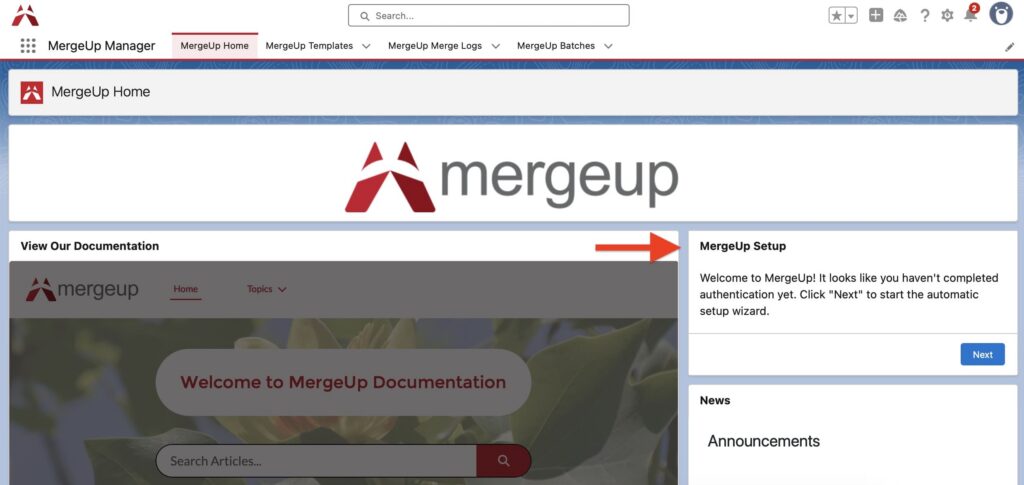
With MergeUp, the alternative to Conga Composer, setup is faster. After installing, admins can run the quick configuration flow, which takes about a minute. Once completed, they can launch the template builder to upload and customize Word or PDF templates directly.
The AI template builder automatically maps Salesforce fields to the right spots in the document. A live preview shows how the document will look before finalizing, so the first result can be ready within minutes.
Template Building and Maintenance
- Upload Existing Document: Start by uploading a file.
- Auto-Field Detection: The system automatically detects Salesforce fields and maps them using your object schema.
- Match Review: Review detected fields and adjust where needed.
- Admin UI Edits: Make quick changes in a simple admin interface.
- Preview Cycle: Run live previews to check accuracy and finalize in minutes.

Logic, Loops, and Complex Data
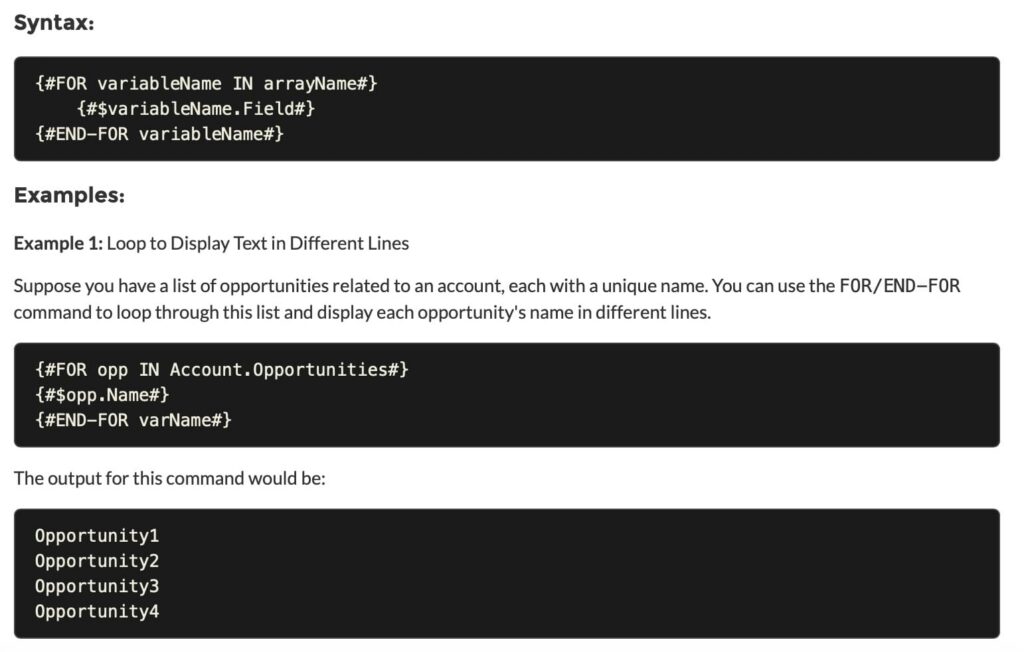
MergeUp makes logic easier to handle with built-in snippets and expressions:
- Conditional Example: Show a discount row only if the discount value is greater than zero.
- Looping Example: Add all line items from an opportunity into a table automatically.
- JavaScript Expressions: Use simple expressions for grouping or calculations, such as totals, averages, or currency conversions, without changing the Salesforce data model.
JavaScript can be helpful when teams want quick calculations in the document itself, but for straightforward templates, it may not be necessary. This gives admins flexibility without forcing complexity into every template.
Output Quality and Formats
A good document generation tool must do more than just merge fields. Teams looking for Conga Composer alternatives in Salesforce often expect clean layouts, dynamic tables that adjust to the data, image support, reliable page breaks, and multi-language options for global use. MergeUp focuses on making high-quality outputs fast and accurate, with live previews that help admins adjust before finalizing. The new format, such as PowerPoint, is now available, making it easier for teams to cover more scenarios without changing tools.

What is the Conga Composer App
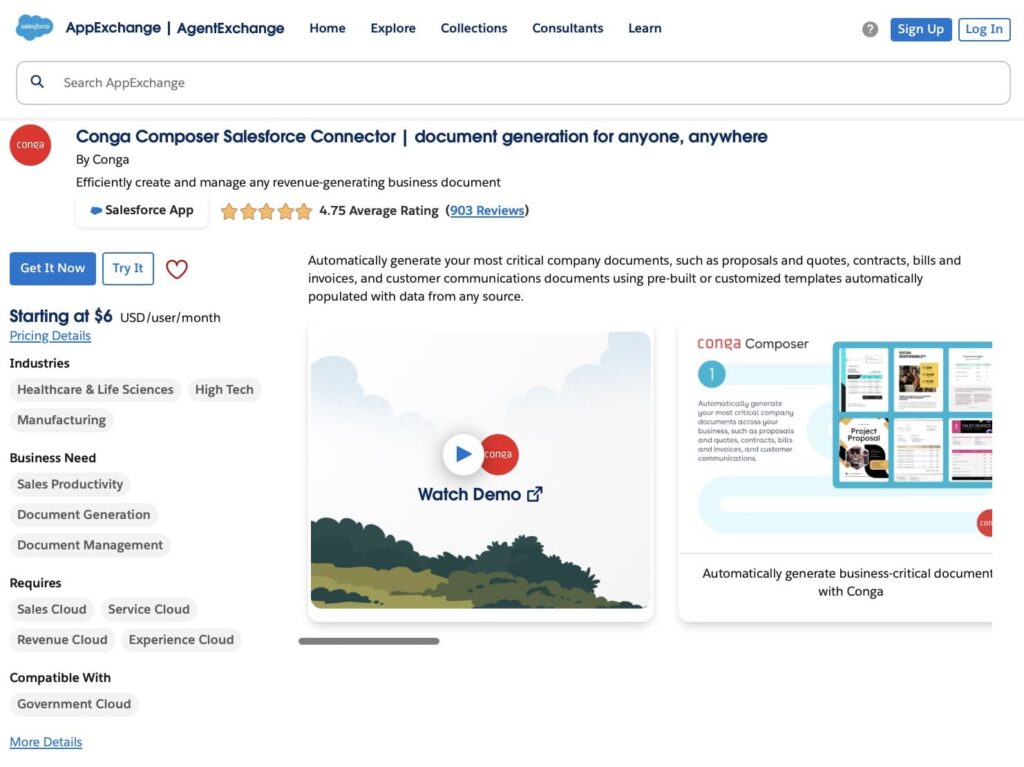
Conga Composer on AppExchange
Salesforce Conga Composer is one of the most established document generation tools for Salesforce. It helps businesses automate the creation of proposals, contracts, invoices, and other key documents, ensuring consistency and control across the customer lifecycle.
Key features include:
- Template-Based Generation: Build documents with pre-designed or custom templates populated with Salesforce and external data.
- Multi-Format Output: Generate PDFs, Word, Excel, PowerPoint, and HTML with support for images, tables, charts, and branding.
- API & Embedding: Merge data from any source and embed Composer into websites, apps, or platforms for seamless delivery.
- Automation & Integrations: Easily connect with Salesforce CPQ, CLM, and workflows to accelerate deal cycles.
- Brand & Compliance Control: Standardize layouts, prevent rogue discounting, and eliminate errors from manual document handling.
- Advanced Content Handling: Support for global currencies, watermarks, dashboards, custom fonts, and multi-language formatting.
Why teams choose Conga Composer:
Conga Composer is a proven enterprise-grade solution with deep automation, compliance, and integration features. It’s best suited for organizations that need rigid standardization, multi-system data merging, and tight integration with complex Salesforce processes like CPQ and CLM.
Setup and First Document

After installation, teams need to assign permissions and set up data sources. The first template usually means working with Word or Excel and inserting Conga tags to pull data from Salesforce. Once the tags are in place, users can run a merge to create the document. This works well but takes some time, especially for those new to the tagging system.
Template Building and Maintenance
- Tag Creation: Build templates by inserting Conga tags into Word, Excel, or PowerPoint files.
- Data Sources: Define and connect Salesforce reports, queries, or views to feed data into templates.
- Template Versioning: Manage updates and keep different template versions for various use cases.
- Upkeep: When Salesforce fields change, templates often need manual updates to avoid errors.
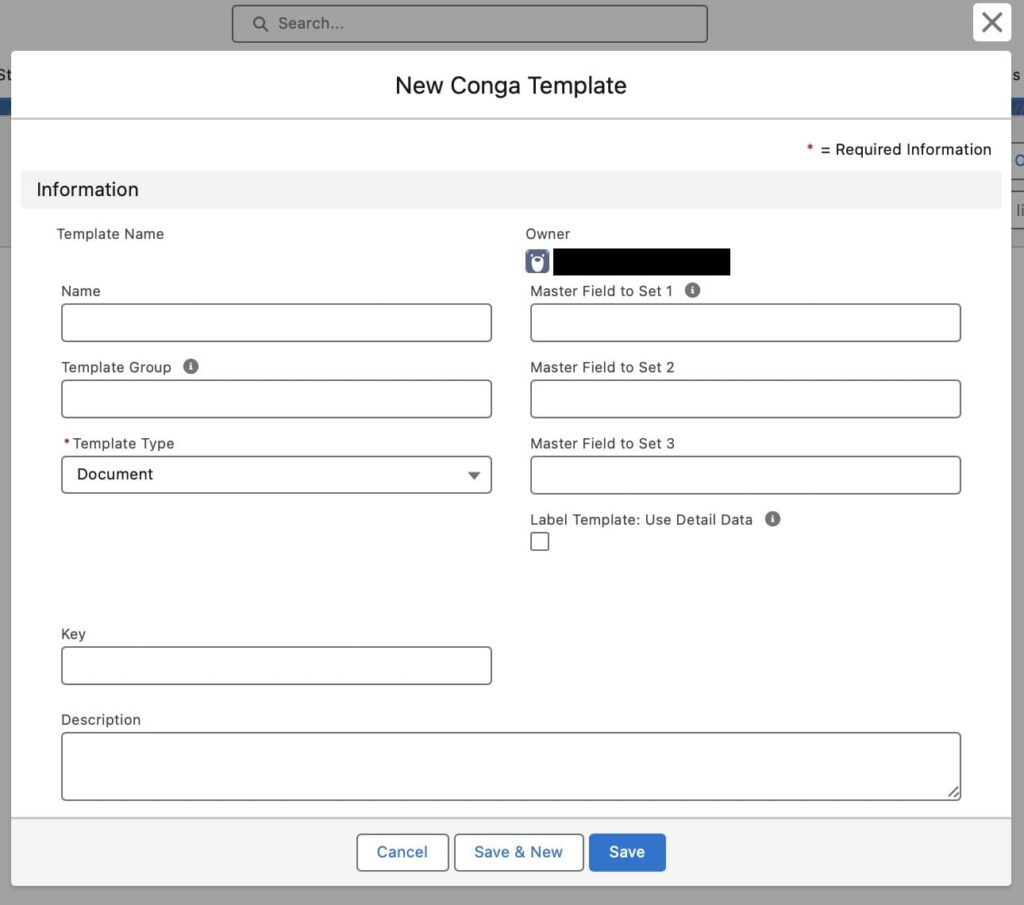
Logic, Loops, and Complex Data

Conga Composer for Salesforce uses its own syntax for adding logic inside templates. Admins can create conditional sections, such as showing a clause only when a checkbox is true. Composer also supports looping through child rows, like listing all opportunity products or related contacts. It is powerful, but writing and testing the syntax can take extra time.
Output Quality and Formats
Conga has long supported multiple formats, including PDF, Word, Excel, and PowerPoint. Its template controls allow detailed formatting, though creating complex layouts can require more setup.

Feature-by-Feature Comparison: MergeUp vs. Conga Composer
When comparing document generation tools in Salesforce, the biggest differences show up in how they handle templates, automation, and usability. While both apps cover the core needs of document creation, they take very different approaches depending on whether a team values speed and simplicity or depth and enterprise control. We are going to check different features and give a star rating to each App. Also, we will sum up all the stars in the end to decide who is the clear winner in this epic battle of doc gen apps, Salesforce.
| Feature Comparison: MergeUp vs. Conga Composer | ||
|---|---|---|
| Feature | MergeUp | Conga Composer |
| Setup | The AI-powered wizard can map Salesforce fields automatically; live in 15 mins. | Setting up a manual template can require more time and training. |
| Template Management | Admin-friendly UI with copy/paste merge fields, preview, and rules builder. | Template management is spread across multiple tabs within the app, with a disconnected interface. |
| Logic & Looping | Conditional sections, child records, flexible tables, and JavaScript. | Strong loops for related lists and conditional clauses, but syntax-heavy. |
| Automation | Flow integration, batch generation included in MergeUp upfront cost, API support for bulk and stitched docs. | Full automation: buttons, Flow, Apex, APIs, CPQ & CLM integrations; batch generation requires a separate add-on. |
| Output Formats | PDF, Word and, in the latest release, PowerPoint and Excel support. | PDF, Word, Excel, PowerPoint, HTML. |
| Performance | Fast on large batches; stable runtime in Flow and API jobs; handles long templates with related data. | Strong on complex, mixed-format runs; handles large templates with images and conditionals at enterprise scale. |
| Branding | Offers fully styled Microsoft Word templates with control over fonts, logos, layouts, and colors, ensuring pixel-perfect PDF or Word outputs. | Allows incorporation of company branding into documents and the platform’s user interface to maintain consistency and trust with every recipient. |
| Total stars |      |
    |
Key Takeaways
- Ease of Use: MergeUp is fast to set up with AI-powered templates. Conga Composer works well but needs more admin knowledge.
- Template & Logic: MergeUp is simple with copy/paste fields and rules. Conga supports complex loops but uses heavier syntax.
- Automation & Formats: MergeUp offers fast batch generation and flexibility for large businesses with specific use cases, while many customers switch from Conga because they couldn’t integrate their enterprise systems effectively.
Security and Governance: MergeUp vs. Conga Composer
When choosing Salesforce document generation tools, security and governance are as important as speed and features. Both MergeUp and Conga Composer respect Salesforce’s security model, including profiles, permissions, and record-level access, ensuring that only authorized users can generate or view documents.
File storage is flexible: output can be stored in Salesforce Files or directed to other approved repositories. For example, for teams that want to store documents in SharePoint or other external repositories, Upsource Solutions also offers the sFiles app, which seamlessly connects Salesforce to SharePoint. This makes it easy to manage generated documents across platforms without leaving Salesforce. Admins can also configure governance controls, such as deciding who can run bulk merges, enforcing consistent naming rules for templates and output files, and applying retention policies to old documents.
| Security and Governance: MergeUp vs. Conga Composer | ||
|---|---|---|
| Security Aspect | MergeUp | Conga Composer |
| Access control | Uses Salesforce profiles and permission sets | Uses Salesforce profiles and permission sets, plus enterprise role models. But some recent Conga reviews on AppExchange have raised concerns about its security setup and required permissions. |
| File storage | Salesforce Files; other options depend on org setup | Salesforce Files or integrated external storage |
| Governance | Admins control merges, naming rules, and retention | Admins control merges, naming rules, and retention |
| Audit | Provides merge logs to track document generation and maintains template version history. | Leverages Salesforce audit trails and Composer’s document history |
| Total stars |      |
    |
Scalability Comparison: MergeUp vs. Conga Composer
Scalability matters when your team grows or your document needs become more complex. Some tools handle generating large batches of documents smoothly, while others can slow down or require additional setup. MergeUp’s tier-based, per-org pricing helps control costs as teams expand, avoiding the extra time and expense of acquiring individual user licenses, which is often required with Conga Composer. Here’s how MergeUp and Conga Composer compare in terms of scaling with your business.
| Scalability Comparison: MergeUp vs. Conga Composer | ||
|---|---|---|
| Scalability Aspect | MergeUp | Conga Composer |
| Record Volume | Capable of generating large batches of documents efficiently; performance depends on template complexity and data size. | Handles large volumes of documents efficiently; performance depends on template complexity and data size. |
| Template Load | Supports multiple templates; AI mapping reduces maintenance effort. | Supports multiple templates; managing many complex templates may require extra setup. |
| Multi-Object Documents | Easily handles child objects, related lists, and complex tables. | Strong support for related objects and lists; may require Composer syntax adjustments. |
| Automation at Scale | Fully integrates with Flow and APIs for bulk processing. | Supports Flow, Apex, batch jobs for additional cost, and API integrations for enterprise use. |
| Team Size Impact | Works well for small to mid-sized teams without extra configuration. | Designed for mid-to-large teams; setup can become complex as team size grows. |
| Global / Multi-Language | Handles basic multi-language templates; additional logic may require manual adjustments. | Supports multi-language, global currencies, and advanced formatting for international teams. |
| Total stars |      |
     |
Pricing Overview
When comparing Salesforce document generation solutions, pricing can be a key factor. MergeUp and Conga Composer follow different approaches, which can affect the total cost of ownership depending on team size and usage.
- MergeUp typically uses a per-org subscription, which covers all users in the organization. Setup packages and support tiers are included in the subscription, making it easier for smaller teams to budget. More details on the official site.
- Conga Composer usually follows a per-user model, often with optional add-ons and tiered support. This can increase costs for larger teams, but provides flexibility for complex deployments.
Here’s a simple comparison table:
| Pricing Comparison: MergeUp vs. Conga Composer | ||
|---|---|---|
| Feature | MergeUp | Conga Composer |
| Pricing Model | Per-org subscription. Lowest cost starting at $2,500 per year (org size may vary). | Per-user subscription ($6 USD/user/month listed on AppExchange as lowest starting price; actual pricing requires a quote) |
| Setup Packages | Included (Silver, Gold, Platinum) | Optional / Add-ons |
| Support Tiers | Standard included. (Enhanced and Premium can be added for additional cost) | Tiered (Standard, Premium) |
| Total Cost for Small Teams | ~$2,500 per year (1–10 users) | Custom price |
| Total Cost for Medium Teams | ~$5,000 – $7,000 per year (11–100 users) | Custom price |
| Total Cost for Large Teams | ~$15,000–$30,000 per year (101–500+ users) | Custom price |
| Total stars |      |
   |
Note: Conga Composer pricing varies by edition and add-ons; the $6/user/month figure is the lowest entry-level price on AppExchange, but most enterprise contracts are much higher. MergeUp pricing, the Conga Composer alternative, is published and fixed per org, with no per-user charges.
Key Takeaways
- Pricing Model: MergeUp uses a per-org subscription with setup and support included, making costs predictable. Conga Composer uses a per-user model with optional add-ons, which can make total costs unclear.
- Budgeting for Teams: MergeUp is easier for small and medium teams to plan. Conga may require a quote for accurate pricing, especially for larger deployments.
What Users Say: MergeUp vs. Conga Composer
When evaluating Salesforce document generation apps, user reviews can provide valuable insights into real-world experience. The reviews were taken from AppExchange and analyzed to make it easy for you.
| What Users Say: MergeUp vs. Conga Composer | ||
|---|---|---|
| Feature | MergeUp | Conga Composer |
| Average Rating on AppExchange | 5  |
4.75  |
| Ease of Use | Templates are easy to set up; AI mapping reduces effort. | Powerful but requires technical skill; template syntax can be complex. |
| Support | Highly responsive, timely, and helpful. | Mixed reviews; long response times for some cases. |
| Admin Experience | Intuitive UI, versioning, and logs make management simple. | The complicated admin panel, documentation can be overwhelming. |
| Performance | Handles complex layouts and batch generation smoothly. | Reliable for many document types, but some users report slow processing. |
| Pricing Transparency | Clear per-org pricing. | Per-user with add-ons; total cost often unclear for enterprise teams. |
| Total stars |      |
    |
Key Takeaways
- MergeUp is praised for its intuitive setup, AI-powered templates, and responsive support team. Users highlight that templates are easy to build, even with complex layouts, and batch document generation works reliably. The Admin UI and logs make it easy for admins to manage documents without heavy technical work.
- Conga Composer, while well-established and widely used, receives mixed reviews. Users appreciate its flexibility, format support, and enterprise-grade capabilities. However, some report a steep learning curve, complex admin setup, and slow support response. Pricing can also be unclear, particularly for larger teams.
Making the Right Choice for Your Team
Choosing the right document generation tool depends on your team’s workflow and priorities. Conga Composer works well for complex templates, legacy formatting, and teams familiar with tag-based management, offering broad format support and advanced automation. MergeUp shines for speed and simplicity, with AI-powered template mapping, quick setup, and flexible batch generation without changing the Salesforce data model.
Let’s count stars for each app based on the comparisons in this article:
| Total Stars For Each App | ||
|---|---|---|
| Section | MergeUp | Conga Composer |
| Feature Comparison |      |
    |
| Security and Governance |      |
    |
| Scalability Comparison |      |
     |
| Pricing Comparison |      |
   |
| What Users Say |      |
    |
| Total Stars | 25  |
20  |
After comparing features, pricing, customization, ease of use, and scalability, MergeUp scores 25 stars overall, while Conga Composer totals 20 stars. This makes MergeUp the clear winner for teams looking for a faster, simpler, and more intuitive document generation solution in Salesforce.
Key Takeaways
- Ease of Use: MergeUp provides an intuitive, point-and-click experience with AI-powered template mapping, while Conga Composer requires admin knowledge and more setup time.
- Automation: MergeUp supports batch generation and flexible logic without modifying Salesforce data, while Conga Composer has advanced automation but can require additional configuration.
- Pricing: MergeUp’s per-org subscription makes costs predictable, whereas Conga Composer’s per-user pricing and add-ons can make budgeting more complex.
- Template Management: MergeUp offers simple template building, while Conga Composer supports more complex templates but has a steeper learning curve.
- Support: Users praise MergeUp’s responsive support team, whereas Conga Composer has mixed reviews on responsiveness and support quality.
For teams seeking fast setup, AI-powered templates, and straightforward document automation, MergeUp is the preferred choice. For organizations with complex legacy templates or requiring advanced workflow integration, Conga Composer remains a viable option. Try MergeUp and see how quickly your team can create accurate, professional documents.
The post Top Conga Composer Alternative: MergeUp vs Conga Composer Comparison first appeared on Salesforce Apps.
November 21, 2025 at 02:47PM
Click here for more details...
=============================
The original post is available in Salesforce Apps by Antonina Kharchenko
this post has been published as it is through automation. Automation script brings all the top bloggers post under a single umbrella.
The purpose of this blog, Follow the top Salesforce bloggers and collect all blogs in a single place through automation.
============================

Post a Comment